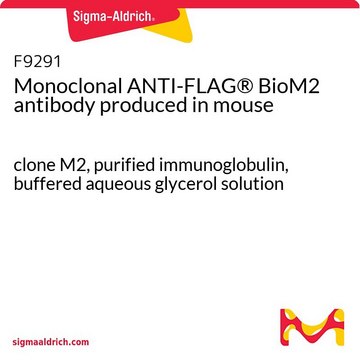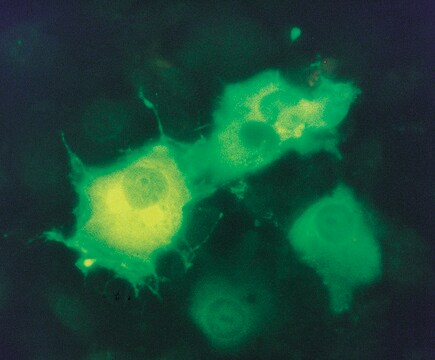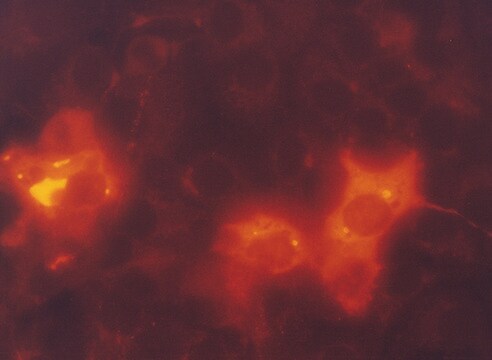B3111
ANTI-FLAG® M2 antibody, Mouse monoclonal
Clone M2, purified from hybridoma cell culture in bioreactor
Synonym(e):
Anti-ddddk, Anti-dykddddk, M2 clone ANTI-FLAG
Anmeldenzur Ansicht organisationsspezifischer und vertraglich vereinbarter Preise
Alle Fotos(7)
About This Item
UNSPSC-Code:
12352203
NACRES:
NA.43
Empfohlene Produkte
Biologische Quelle
mouse
Antikörperform
purified immunoglobulin (purified IgG1 subclass)
Klon
M2, monoclonal
Haltbarkeit
4 yr
Aufgereinigt durch
using Protein A
Lagertemp.
−20°C
Allgemeine Beschreibung
Monoclonal ANTI-FLAG M2 is a purified immunoglobulin, IgG1, monoclonal antibody, purified from culture supernatant of hybridoma cells, that binds to FLAG® fusion proteins. Unlike ANTI-FLAG M1 antibody, the M2 antibody will recognize the FLAG sequence at the N-terminus, Met-N-terminus, C-terminus, or at an internal site of FLAG fusion proteins. Monoclonal ANTI-FLAG M2 is useful for identification and capture of FLAG fusion proteins by common immunological procedures such as Western blots and immunoprecipitation. It is also useful for affinity purification of FLAG fusion proteins when bound to a solid support.
form: solution pH 7.4, containing 15 mM sodium azide
concentration: 3.0-5.0 mg/mL
form: solution pH 7.4, containing 15 mM sodium azide
concentration: 3.0-5.0 mg/mL
Anwendung
IB, IF, IP, FACS, ELISA
Antibody is recommended for use in several applications such as immunoblotting, immunoprecipitation, immunofluorescence, flow cytometry, and ELISA.
Learn more product details in our FLAG® application portal.
Antibody is recommended for use in several applications such as immunoblotting, immunoprecipitation, immunofluorescence, flow cytometry, and ELISA.
Learn more product details in our FLAG® application portal.
Verpackung
polypropylene screw cap vial
Angaben zur Herstellung
Dilute the antibody solution from 0.5-10 ug/mL in specified buffer
Rechtliche Hinweise
ANTI-FLAG is a registered trademark of Merck KGaA, Darmstadt, Germany
FLAG is a registered trademark of Merck KGaA, Darmstadt, Germany
Lagerklassenschlüssel
12 - Non Combustible Liquids
WGK
nwg
Flammpunkt (°F)
Not applicable
Flammpunkt (°C)
Not applicable
Hier finden Sie alle aktuellen Versionen:
Analysenzertifikate (COA)
Lot/Batch Number
It looks like we've run into a problem, but you can still download Certificates of Analysis from our Dokumente section.
Wenn Sie Hilfe benötigen, wenden Sie sich bitte an Kundensupport
Besitzen Sie dieses Produkt bereits?
In der Dokumentenbibliothek finden Sie die Dokumentation zu den Produkten, die Sie kürzlich erworben haben.
Yi-Min Chu et al.
Frontiers in oncology, 12, 900166-900166 (2022-10-04)
DLC1 (deleted in liver cancer-1) is downregulated or deleted in colorectal cancer (CRC) tissues and functions as a potent tumor suppressor, but the underlying molecular mechanism remains elusive. We found that the conditioned medium (CM) collected from DLC1-overexpressed SW1116 cells
Yanchen Ma et al.
Glia, 70(2), 379-392 (2021-11-02)
Myelin sheath is an important structure to maintain functions of the nerves in central nervous system. Protein palmitoylation has been established as a sorting determinant for the transport of myelin-forming proteins to the myelin membrane, however, its function in the
Jiajia Zhang et al.
Cancer letters, 501, 43-54 (2020-12-29)
TP53 binding protein 1 (53BP1) plays an important role in DNA damage repair and maintaining genomic stability. However, the mutations of 53BP1 in human cancers have not been systematically examined. Here, we have analyzed 541 somatic mutations of 53BP1 across
Maria Jesús García-Murria et al.
Nature communications, 11(1), 6056-6056 (2020-11-29)
Viral control of programmed cell death relies in part on the expression of viral analogs of the B-cell lymphoma 2 (Bcl2) protein known as viral Bcl2s (vBcl2s). vBcl2s control apoptosis by interacting with host pro- and anti-apoptotic members of the
Silvia Martini et al.
Nature communications, 12(1), 6934-6934 (2021-11-28)
The PKCε-regulated genome protective pathway provides transformed cells a failsafe to successfully complete mitosis. Despite the necessary role for Aurora B in this programme, it is unclear whether its requirement is sufficient or if other PKCε cell cycle targets are
Unser Team von Wissenschaftlern verfügt über Erfahrung in allen Forschungsbereichen einschließlich Life Science, Materialwissenschaften, chemischer Synthese, Chromatographie, Analytik und vielen mehr..
Setzen Sie sich mit dem technischen Dienst in Verbindung.








